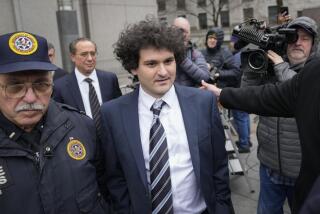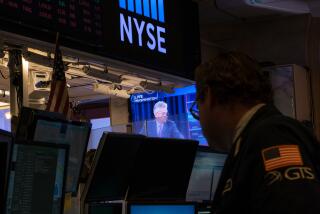They get a loan, we pay the price
- Share via
The conventional wisdom on the multibillion-dollar federal government bailout of mortgage giants Fannie Mae and Freddie Mac is that they’re just too big to let fail. The two companies own or guarantee about half of the country’s $12 trillion in mortgage debt.
Another way of looking at this, though, is that all those of us who behaved responsibly during the housing bubble will now have to cover for those who rolled the dice and lost when it came to home prices and mortgage payments.
How much does that bite?
“If Fannie and Freddie were to fail, that could trigger a real banking crisis,” said Delores Conway, director of USC’s Casden Real Estate Economics Forecast. “This bailout is for the greater good.”
It’s unclear how much of taxpayers’ money will be used for the bailout. Current estimates say it could run as high as $200 billion. That’s about $655 for every man, woman and child.
“It’s tough,” Conway said. “The pain is being spread among consumers who were honest, ethical and forthright.”
The bailout of Fannie and Freddie is intended primarily to ensure that funds exist for new home buyers, thus preventing the housing market from tanking further. It’s also an effort to placate foreign investors who purchased mortgage-backed securities with the idea that they bore the full faith and credit of the U.S. government.
Fannie and Freddie were private companies. But because they were federally chartered, there was a perception among other countries’ central banks that their debt was guaranteed by the U.S. government. It wasn’t. But it could be disastrous if foreign investors dumped their holdings.
Some taxpayer money also could go toward rewriting the terms of existing loans so that the flood of foreclosures will ease to a more manageable trickle.
Last year, I had to take out a huge (for me) and exotic mortgage when I bought a house after returning to Los Angeles. My wife and I figured this was the best way to get our son enrolled in the public school we wanted him to attend even though we hadn’t yet sold our home in San Francisco.
I knew going into the deal that I couldn’t carry two mortgages for very long and that I’d have to get out of our new loan as quickly as possible. The initial payments weren’t exorbitant, but the interest rate could (and almost certainly would) ratchet higher after three years.
We paid down the principal as soon as we sold our other house. Then, once interest rates hit a sweet spot, we spent about $6,000 to refinance into a conventional fixed-rate loan. It was expensive, but it was the prudent thing to do.
Compare my experience with that of Allen Morgan, who put down $60,000 in cash and took out a $580,000 loan from Countrywide Financial Corp. in 2004 to purchase a five-bedroom house in Woodcrest, in Riverside County.
Like me, he signed up for an unconventional loan that required him to pay interest only before reducing the principal. This structure all but guarantees a steep hike in monthly payments within just a few years.
Morgan, 64, said he refinanced in 2006 into a pair of loans from IndyMac Bank totaling $695,000 and used the additional funds to put in new landscaping, a new patio and a new driveway. One loan had an 8% interest rate, the other nearly 11%.
In October, Morgan said he contacted IndyMac about refinancing again, this time consolidating the two loans into a single obligation with an interest rate of about 5%. He said the bank was concerned that the value of his house had fallen significantly and dithered for months in approving the deal.
In the meantime, Morgan said he found a house in Corona that he was able to buy cheap out of foreclosure, so he stopped making payments on the Woodcrest property in April. His debt and penalty fees now top $700,000.
Morgan expects the house to be foreclosed upon any day now -- another link in the long chain of mortgage defaults that’s brought Fannie, Freddie, IndyMac and other institutions to the edge of a financial cliff.
I asked Morgan why I (and you) should have to pay for his recklessness.
“I understand what you’re saying,” he replied.
“But it’s not me. It’s the big institutions we need to be watching more closely. They’re the ones holding the notes. They were obligated to take care of me.”
Economists talk about a concept called moral hazard, which describes a situation in which an individual or institution exhibits unusually risky behavior because the consequences for such actions are diminished.
“The last thing you want is for people to think they can make mistakes and that they’ll get rescued,” said Alan Auerbach, director of the Robert D. Burch Center for Tax Policy and Public Finance at UC Berkeley.
But what else are we to think when billions of dollars of our money is essentially handed to those who gambled wrong on the mortgage market? How is that fair?
“You just have to suck it up,” said Ed Leamer, director of the UCLA Anderson Forecast.
“You’ll benefit in the long run from having a stronger economy. That’s what you have to remember.”
Perhaps. But taxpayers are sick of getting stuck with the check for someone else’s banquet.
The federal government will run a near-record deficit of $407 billion this year, according to congressional estimates released Tuesday. The tide of red ink will rise to $438 billion next year.
Meanwhile, the national debt is approaching a staggering $10 trillion -- a credit card bill that future generations are going to have to pay, one way or another. Clearly it’s time we got our financial house in order.
Fannie and Freddie may be too big to let fail. But it should stop there.
--
Consumer Confidential runs Wednesdays and Sundays.
Send your tips or feedback to david.lazarus@latimes.com.
--
On latimes.com
Discussion
How do you feel about the “greater good” of bailing out Fannie Mae and Freddie Mac? latimes.com/lazarus/bailout
More to Read
Inside the business of entertainment
The Wide Shot brings you news, analysis and insights on everything from streaming wars to production — and what it all means for the future.
You may occasionally receive promotional content from the Los Angeles Times.











